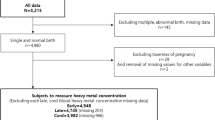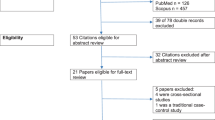Abstract
This study aims to review the epidemiological studies on the association between cadmium (Cd) exposure during pregnancy and neonatal anthropometric measures. Electronic search of PubMed, Scopus, Web of Science, and Cochrane Collaboration was conducted till end of 2018. Pooled estimates were performed using a fixed-effects model or random-effects model. A total of 22 studies included in the meta-analyses. Subgroup analyses on sample type (maternal urine, maternal blood, cord blood, and placenta), meta-regression, and sensitivity analysis were performed to seek the sources of heterogeneity. In the random-effects meta-analysis of included studies, the pooled correlation coefficient between maternal exposure to Cd with birth weight was − 0.04 [95% CI (− 0.07, − 0.01), with birth length and head circumference as − 0.01 [95% CI (− 0.04, 0.02)] and − 0.02 [95% CI (− 0.06, 0.02)]. Our findings showed significant relationship between Cd exposure of pregnant women with low birth weight, but not with birth length and head circumference.






Similar content being viewed by others
Refrences
Waisberg M, Black W, Waisberg C, Hale B (2004) The effect of pH, time and dietary source of cadmium on the bioaccessibility and adsorption of cadmium to/from lettuce (Lactuca sativa L. cv. Ostinata). FCT J 42:835–842. https://doi.org/10.1016/j.fct.2004.01.007
Järup L, Åkesson A (2009) Current status of cadmium as an environmental health problem. TAAP J 238:201–208. https://doi.org/10.1016/j.taap.2009.04.020
Alexander J, Benford D, Cockburn A, Cravedi JP, Dogliotti E et al (2009) Scientific opinion of the panel on contaminants in the food chain. EFSA J 980:1–139
Straif K, Benbrahim-Tallaa L, Baan R, Grosse Y, Secretan B, El Ghissassi F et al (2009) A review of human carcinogens—part C: metals, arsenic, dusts, and fibers. Lancet Oncol J 10:453–454. https://doi.org/10.1016/S1470-2045(09)70134-2
Henson MC, Chedrese PJ (2004) Endocrine disruption by cadmium, a common environmental toxicant with paradoxical effects on reproduction. Exp Biol Med (Maywood) 229:383–392. https://doi.org/10.1177/153537020422900506
Kelishadi R, Askarieh A, Motlagh ME, Tajadini M, Heshmat R, Ardalan G et al (2013) Association of blood cadmium level with cardiometabolic risk factors and liver enzymes in a nationally representative sample of adolescents: the CASPIAN-III study. J Environ Public Health. https://doi.org/10.1155/2013/142856
Sutton P, Giudice LC, Woodruff TJ (2010) Reproductive environmental health. Curr Opin Obstet Gynecol 22:517–524. https://doi.org/10.1097/GCO.0b013e3283404e59
Ferguson KK, O’Neill MS, Meeker JD (2013) Environmental contaminant exposures and preterm birth: a comprehensive review. J Toxicol Environ Health B 16:69–113. https://doi.org/10.1080/10937404.2013.775048
Windham G, Fenster L (2008) Environmental contaminants and pregnancy outcomes. Fertil Steril 89:e111–e116. https://doi.org/10.1016/j.fertnstert.2007.12.041
Diaz-Jimenez J, Arroyo V, Ortiz Burgos C, Carmona Alferez R, Linares Gil C (2016) Effect of environmental factors on low weight in non-premature births: a time series analysis. PLoS One. https://doi.org/10.1371/journal.pone.0164741
Kippler M, Tofail F, Gardner R, Rahman A, Hamadani JD, Bottai M et al (2011) Maternal cadmium exposure during pregnancy and size at birth: a prospective cohort study. Environ Health Perspect 120:284–289. https://doi.org/10.1289/ehp.1103711
Lin CM, Doyle P, Wang D, Hwang YH, Chen PC (2011) Does prenatal cadmium exposure affect fetal and child growth? Environ Int 68:641–646. https://doi.org/10.1136/oem.2010.059758
Kippler M, Wagatsuma Y, Rahman A, Nermell B, Persson LÅ, Raqib R et al (2012) Environmental exposure to arsenic and cadmium during pregnancy and fetal size: a longitudinal study in rural Bangladesh. Reprod Toxicol 34:504–511. https://doi.org/10.1016/j.reprotox.2012.08.002
MacDorman MF, Mathews T (2013) Infant deaths-United States, 2005–2008. MMWR Surveill Summ 62:171–175
Butler AS, Behrman RE (2007) Preterm birth: causes, consequences, and prevention. Institute of Medicine (US) Committee on Understanding Premature Birth and Assuring Healthy Outcomes
Llanos MN, Ronco AM (2009) Fetal growth restriction is related to placental levels of cadmium, lead and arsenic but not with antioxidant activities. Reprod Toxicol 27:88–92. https://doi.org/10.1016/j.reprotox.2008.11.057
Shirai S, Suzuki Y, Yoshinaga J, Mizumoto Y (2010) Maternal exposure to low-level heavy metals during pregnancy and birth size. J Environ Sci Health A 45:1468–1474. https://doi.org/10.1080/10934529.2010.500942
Zhang YL, Zhao YC, Wang JX, Zhu HD, Liu QF, Fan YG et al (2004) Effect of environmental exposure to cadmium on pregnancy outcome and fetal growth: a study on healthy pregnant women in China. J Environ Sci Health A 39:2507–2515. https://doi.org/10.1081/ESE-200026331
Nishijo M, Nakagawa H, Honda R, Tanebe K, Saito S, Teranishi H et al (2002) Effects of maternal exposure to cadmium on pregnancy outcome and breast milk. Occup Environ Med 59:394–397. https://doi.org/10.1136/oem.59.6.394
Bloom MS, Louis GMB, Sundaram R, Maisog JM, Steuerwald AJ, Parsons PJ (2015) Birth outcomes and background exposures to select elements, the Longitudinal Investigation of Fertility and the Environment (LIFE). Environ Res 138:118–129. https://doi.org/10.1016/j.envres.2015.01.008
Moher D, Liberati A, Tetzlaff J, Altman DG (2009) Preferred reporting items for systematic reviews and meta-analyses: the PRISMA statement. Ann Intern Med 151:264–269. https://doi.org/10.7326/0003-4819-151-4-200908180-00135
Von Elm E, Altman DG, Egger M, Pocock SJ, Gøtzsche PC, Vandenbroucke JP (2007) The Strengthening the Reporting of Observational Studies in Epidemiology (STROBE) statement: guidelines for reporting observational studies. Ann Intern Med 147:573–577. https://doi.org/10.7326/0003-4819-147-8-200710160-00010
Patsopoulos NA, Evangelou E, Ioannidis JP (2008) Sensitivity of between-study heterogeneity in meta-analysis: proposed metrics and empirical evaluation. Int J Epidemiol 37:1148–1157. https://doi.org/10.1093/ije/dyn065
Guo J, Wu C, Qi X, Jiang S, Liu Q, Zhang J et al (2017) Adverse associations between maternal and neonatal cadmium exposure and birth outcomes. Sci Total Environ 575:581–587. https://doi.org/10.1016/j.scitotenv.2016.09.016
Huang K, Li H, Zhang B, Zheng T, Li Y, Zhou A et al (2017) Prenatal cadmium exposure and preterm low birth weight in China. J Expo Sci Environ Epidemiol. https://doi.org/10.1038/jes.2016.41
Hu X, Zheng T, Cheng Y, Holford T, Lin S, Leaderer B et al (2015) Distributions of heavy metals in maternal and cord blood and the association with infant birth weight in China. J Reprod Med 60:21–29
Sun H, Chen W, Wang D, Jin Y, Chen X, Xu Y (2014) The effects of prenatal exposure to low-level cadmium, lead and selenium on birth outcomes. Chemosphere 108:33–39. https://doi.org/10.1016/j.chemosphere.2014.02.080
Zhang Y, Xu X, Chen A, Davuljigari CB, Zheng X, Kim SS et al (2018) Maternal urinary cadmium levels during pregnancy associated with risk of sex-dependent birth outcomes from an e-waste pollution site in China. Reprod Toxicol 75:49–55. https://doi.org/10.1016/j.reprotox.2017.11.003
Yang J, Huo W, Zhang B, Zheng T, Li Y, Pan X et al (2016) Maternal urinary cadmium concentrations in relation to preterm birth in the Healthy Baby Cohort Study in China. Environ Int 94:300–306. https://doi.org/10.1016/j.envint.2016.06.003
Cheng L, Zhang B, Zheng T, Hu J, Zhou A, Bassig B et al (2017) Critical windows of prenatal exposure to cadmium and size at birth. Int J Environ Res Public Health. https://doi.org/10.3390/ijerph14010058
Falcon M, Vinas P, Perez-Carceles M, Luna A (2003) Placental cadmium and lipid peroxidation in smoking women related to newborn anthropometric measurements. Arch Environ Contam Toxicol 45:278–282. https://doi.org/10.1007/s00244-003-0118-1
Bizoń A, Milnerowicz-Nabzdyk E, Zalewska M, Zimmer M, Milnerowicz H (2011) Changes in pro/antioxidant balance in smoking and non-smoking pregnant women with intrauterine growth restriction. Reprod Toxicol 32(3):360–367. https://doi.org/10.1016/j.reprotox.2011.08.007
Kantola M, Purkunen R, Kröger P, Tooming A, Juravskaja J, Pasanen M et al (2000) Accumulation of cadmium, zinc, and copper in maternal blood and developmental placental tissue: differences between Finland, Estonia, and St. Petersburg. Environ Res 83:54–66. https://doi.org/10.1006/enrs.1999.4043
Salpietro CD, Gangemi S, Minciullo PL, Briuglia S, Merlino MV, Stelitano A et al (2002) Cadmium concentration in maternal and cord blood and infant birth weight: a study on healthy non-smoking women. J Perinat Med 30:395–399. https://doi.org/10.1515/JPM.2002.061
Luo Y, McCullough LE, Tzeng J-Y, Darrah T, Vengosh A, Maguire RL et al (2017) Maternal blood cadmium, lead and arsenic levels, nutrient combinations, and offspring birthweight. BMC Public Health. https://doi.org/10.1186/s12889-017-4225-8
Vidal AC, Semenova V, Darrah T, Vengosh A, Huang Z, King K et al (2015) Maternal cadmium, iron and zinc levels, DNA methylation and birth weight. BMC Pharmacol Toxicol. https://doi.org/10.1186/s40360-015-0020-2
Loiacono NJ, Graziano JH, Kline JK, Popovac D, Ahmedi X, Gashi E et al (1992) Placental cadmium and birthweight in women living near a lead smelter. Arch Environ Health 47:250–255. https://doi.org/10.1080/00039896.1992.9938357
Kuhnert B, Kuhnert P, Debanne S, Williams T The relationship between cadmium zinc and birth weight in pregnant women who smoke. Am J Obstet Gynecol 157:1247–1251. https://doi.org/10.1016/S0002-9378(87)80303-4
Röllin HB, Kootbodien T, Channa K, Odland JØ (2015) Prenatal exposure to cadmium, placental permeability and birth outcomes in coastal populations of South Africa. PLoS One. https://doi.org/10.1371/journal.pone.0142455
Tawari E, Anetor J, Charles-davis M (2013) Cadmium levels in pregnancy, influence on neonatal birth weight and possible Amelioration by some essential trace elements. Toxicol Int 20:108–112. https://doi.org/10.4103/0971-6580.111558
Vilahur N, Vahter M, Broberg K (2015) The epigenetic effects of prenatal cadmium exposure. Curr Environ Health Rep 2:195–203. https://doi.org/10.1007/s40572-015-0049-9
Stasenko S, Bradford EM, Piasek M, Henson MC, Varnai VM, Jurasović J et al (2010) Metals in human placenta: focus on the effects of cadmium on steroid hormones and leptin. J Appl Toxicol 30:242–253. https://doi.org/10.1002/jat.1490
Chertok R, Kullgren B, Burbank D (1984) The effects of CdCl2 on the matemal-to-fetal clearance of 67Cu and placental blood flow. Proc Soc Exp Biol Med 176:138–142. https://doi.org/10.3181/00379727-176-41853
Kippler M, Hoque AW, Raqib R, Öhrvik H, Ekström EC, Vahter M (2010) Accumulation of cadmium in human placenta interacts with the transport of micronutrients to the fetus. Toxicol Lett 192:162–168. https://doi.org/10.1016/j.toxlet.2009.10.018
Kippler M, Lönnerdal B, Goessler W, Ekström EC, El Arifeen S, Vahter M (2009) Cadmium interacts with the transport of essential micronutrients in the mammary gland—a study in rural Bangladeshi women. Toxicology. https://doi.org/10.1016/j.tox.2008.12.009
Roohani N, Hurrell R, Kelishadi R, Schulin R (2013) Zinc and its importance for human health: an integrative review. J Res Med Sci 18:144–157
Singh P, Khushlani K, Veerwal P, Gupta R (1987) Maternal hypozincemia and low-birth-weight infants. Clin Chem 33:1950
Nieboer E, Richardson DH (1980) The replacement of the nondescript term ‘heavy metals’ by a biologically and chemically significant classification of metal ions. Environ Pollut (Series B) 1:3–26. https://doi.org/10.1016/0143-148X(80)90017-8
Johnston JE, Valentiner E, Maxson P, Miranda ML, Fry RC (2014) Maternal cadmium levels during pregnancy associated with lower birth weight in infants in a North Carolina cohort. PLoS One. https://doi.org/10.1371/journal.pone.0109661
Odland J, Nieboer E, Romanova N, Thomassen Y, Lund E (1999) Blood lead and cadmium and birth weight among sub-arctic and arctic populations of Norway and Russia. Acta Obstet Gynecol Scand 78:852–860. https://doi.org/10.1034/j.1600-0412.1999.781004.x
Osman K, Åkesson A, Berglund M, Bremme K, Schütz A, Ask K et al (2000) Toxic and essential elements in placentas of Swedish women. Clin Biochem 33:131–138. https://doi.org/10.1016/S0009-9120(00)00052-7
Author information
Authors and Affiliations
Corresponding author
Additional information
Publisher’s Note
Springer Nature remains neutral with regard to jurisdictional claims in published maps and institutional affiliations.
Rights and permissions
About this article
Cite this article
Khoshhali, M., Rafiei, N., Farajzadegan, Z. et al. Maternal Exposure to Cadmium and Fetal Growth: a Systematic Review and Meta-Analysis. Biol Trace Elem Res 195, 9–19 (2020). https://doi.org/10.1007/s12011-019-01819-y
Received:
Accepted:
Published:
Issue Date:
DOI: https://doi.org/10.1007/s12011-019-01819-y




